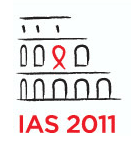 Organizers of the 6th IAS Conference on HIV Pathogenesis, Treatment and Prevention (IAS 2011) kicked off this year’s gathering in Rome by applauding the significant breakthroughs in treatment and prevention science over the past two years, but warned that research discoveries only matter if they can effectively be rolled out evenly throughout the world.
Organizers of the 6th IAS Conference on HIV Pathogenesis, Treatment and Prevention (IAS 2011) kicked off this year’s gathering in Rome by applauding the significant breakthroughs in treatment and prevention science over the past two years, but warned that research discoveries only matter if they can effectively be rolled out evenly throughout the world.
“We are at a scientific watershed in the global AIDS response,” said IAS 2011 international chair and International AIDS Society president Elly Katabira. “We have witnessed two years of significant biomedical advances, the likes of which we have not seen since the antiretroviral breakthroughs of the mid 1990s. The excitement around these advances in research—whether they be the CAPRISA 004 vaginal gel, the HPTN 052 study on treatment as prevention, talk around the path towards a cure, or the encouraging signs on PrEP and vaccines—is very much driving the debates and discussions that we are going to see in Rome over the next few days.”
In his opening session keynote speech, UNAIDS Executive Director Michel Sidibé said that gaps in access to HIV treatment within and between countries and key populations were an affront to humanity that can and must be closed by innovations in developing, pricing and delivering treatments and commodities for HIV, TB, malaria, reproductive health and other health issues.
“We have to remember that history will judge us not by our scientific breakthroughs, but how we apply them,” said Sidibé. The IAS Conference series focuses on the translation of research into practice, particularly in low- and middle-income countries.
More than 5,000 researchers, scientists, health care providers, community leaders and policy experts have gathered in Rome for IAS 2011. This year’s conference, which takes place semi-annually, began Sunday, July 17, and is set to conclude Wednesday, July 20.






1 Comment
1 Comment